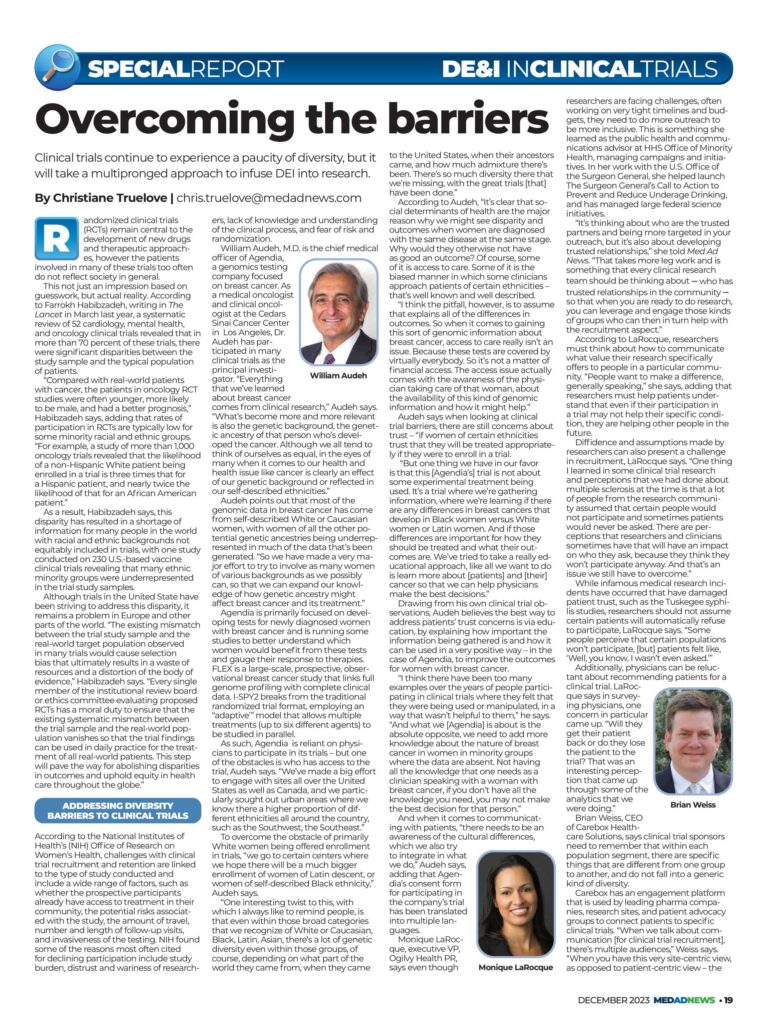
Helping Women with Gynecologic Cancers Find New Treatment Options
Randomized clinical trials (RCTs) remain central to the development of new drugs and therapeutic approaches, however the patients involved in many of these trials too often do not reflect society in general.
This not just an impression based on guesswork, but actual reality. According to Farrokh Habibzadeh, writing in The Lancet in March last year, a systematic review of 52 cardiology, mental health, and oncology clinical trials revealed that in more than 70 percent of these trials, there were significant disparities between the study sample and the typical population of patients.



“Compared with real-world patients with cancer, the patients in oncology RCT studies were often younger, more likely to be male, and had a better prognosis,” Habibzadeh says, adding that rates of participation in RCTs are typically low for some minority racial and ethnic groups. “For example, a study of more than 1,000 oncology trials revealed that the likelihood of a non-Hispanic White patient being enrolled in a trial is three times that for a Hispanic patient, and nearly twice the likelihood of that for an African American patient.”
As a result, Habibzadeh says, this disparity has resulted in a shortage of information for many people in the world with racial and ethnic backgrounds not equitably included in trials, with one study conducted on 230 U.S.-based vaccine clinical trials revealing that many ethnic minority groups were underrepresented in the trial study samples.
Although trials in the United State have been striving to address this disparity, it remains a problem in Europe and other parts of the world. “The existing mismatch between the trial study sample and the real-world target population observed in many trials would cause selection bias that ultimately results in a waste of resources and a distortion of the body of evidence,” Habibzadeh says. “Every single member of the institutional review board or ethics committee evaluating proposed RCTs has a moral duty to ensure that the existing systematic mismatch between the trial sample and the real-world population vanishes so that the trial findings can be used in daily practice for the treatment of all real-world patients. This step will pave the way for abolishing disparities in outcomes and uphold equity in health care throughout the globe.”
According to the National Institutes of Health’s (NIH) Office of Research on Women’s Health, challenges with clinical trial recruitment and retention are linked to the type of study conducted and include a wide range of factors, such as whether the prospective participants already have access to treatment in their community, the potential risks associated with the study, the amount of travel, number and length of follow-up visits, and invasiveness of the testing. NIH found some of the reasons most often cited for declining participation include study burden, distrust and wariness of researchers, lack of knowledge and understanding of the clinical process, and fear of risk and randomization.
…

Additionally, physicians can be reluctant about recommending patients for a clinical trial. LaRocque says in surveying physicians, one concern in particular came up. “Will they get their patient back or do they lose the patient to the trial? That was an interesting perception that came up through some of the analytics that we were doing.”
Brian Weiss, CEO of Carebox Healthcare Solutions, says clinical trial sponsors need to remember that within each population segment, there are specific things that are different from one group to another, and do not fall into a generic kind of diversity.
Carebox has an engagement platform that is used by leading pharma companies, research sites, and patient advocacy groups to connect patients to specific clinical trials. “When we talk about communication [for clinical trial recruitment], there’s multiple audiences,” Weiss says. “When you have this very site-centric view, as opposed to patient-centric view – the hospital, the research center that runs a trial – then you communicate a certain way. Your job as a trial sponsor is to make sure that the trial site understands the requirements and the protocol and what they need to do and who an eligible patient is. That’s a very different agenda from a communication standpoint, so then how do we reach the broadest population of patients possible?”
Traditionally, clinical trials have been very focused on site selection, Weiss says, “If I have a trial in cancer, I’m going to look for the top cancer research centers, and I want them to be my study centers for my trial. That might not be the right way to reach a very diverse population.”
To reach the types of patients they need, trial sponsors need to take a different approach to patient recruitment. “We’re going to do things to reach the audience that we’re trying to target in terms of patients directly, as opposed to indirectly through hospitals or through certain kinds of centers,” Weiss says.
Diversity, according to Weiss, “is really just one of a couple of key trends, which go to that same message of reach[ing] more people directly.” For certain trials that need patients with a specific genetic makeup, “That’s not diversity in the sense that we think about it socially or culturally, but that certainly places challenges on reaching the right population for a trial,” he says.
Patients want to be more involved in their own care, and that includes clinical trials.
“Maybe 50 years ago, being in a clinical trial [meant] your doctor told you, ‘You’re going to be in a clinical trial,’ but it doesn’t work that way anymore,” Weiss says. “We all come with our Dr. Google expertise and we want to be owners of our care plans, we want to be treated as educated healthcare consumers.”
And the use of decentralized trials, accelerated by the COVID-19 pandemic, showed the industry that trials did not have to be done in a hospital, forcing people to travel several times a week. “Can we do more at home? Can we do more at a local pharmacy, can we do more in other kinds of locations?” Weiss adds.
…
The complete article is available by clicking here.

Helping Women with Gynecologic Cancers Find New Treatment Options

Enhancing Access to Clinical Trials for Rare Disease Patients

When We Tri(al) by TOUCH, The Black Breast Cancer Alliance has partnered with Carebox to provide Breasties, caregivers, and the entire Black community with an easy way to search and match to breast cancer clinical trials.

Now patients, caregivers and healthcare professionals have an easy and effective way to search for and match with gastric cancer clinical trials.

Clinical trials continue to experience a paucity of diversity, but it will take a multipronged approach to infuse DEI into research.

Newest Carebox Connect Clinical Trial Sponsor Website Helps Mirati Therapeutics Deliver on Its Commitment to Patient-Centricity

THANC Guide resource center for thyroid, head and neck cancer patients will now feature Carebox Connect for clinical trial search and matching.

Carebox to help LCRF advance lung cancer research by making it easier and more effective for patients, caregivers and healthcare professionals to identify relevant lung cancer trials.

Why aren’t the eligibility criteria of clinical trials searchable? The short answer is: because that’s not where the light is.

Now patients, caregivers and healthcare professionals have an easy and effective way to search and match to scleroderma clinical trials.

Clinical trial websites are not providing the answer to the question that matters most to patients.

CVS Health is winding down its clinical trials business, with a full exit expected by December 31, 2024, the company confirmed to MedCity News. But decentralized clinical trials still have an important role to play, said Brian Weiss, CEO of Carebox.

An invitation to shape how patients find clinical trial treatment options.

Pilot of EHR-embedded clinical trial matching to enhance diversity in cancer research set to begin at two hospital systems in Texas and West Virginia.

Carebox Connect ™ empowers patients, families, and their physicians to find treatment options only available in clinical trials.
© Copyright 2025 by Carebox Healthcare Solutions, Inc.
We strive to answer all inquiries within one business day.

We strive to answer all inquiries within one business day.

Please share your feedback ideas and suggestions to help make Carebox Connect more useful to patients, doctors, trial sites, and/or trial sponsors. No idea is too small and no input is insignificant.
Your message was submitted successfully. We will get back to you within the next few days.
